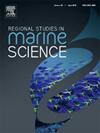Dynamic water quality criteria for estuaries: Exploration and implementation in the Yangtze Estuary
IF 2.4
4区 环境科学与生态学
Q3 ECOLOGY
引用次数: 0
Abstract
Estuaries, as transitional zones between freshwater and seawater, possess unique attributes rendering the application of the Sea Water Quality Standard for assessment inappropriate and inaccurate. To enhance estuarine environmental protection and management, this study developed a dynamic salinity-based water quality criteria system for the Yangtze River Estuary (YRE), integrating existing marine and surface water standards. The estuary was partitioned into three salinity zones: Tidal-controlled Freshwater Zone (TCFZ), Salinity Transition Mixing Zone (STMZ), and Plume-influenced Marine Zone (PIMZ). Applying this system using survey data from six 2021–2022 cruises revealed a significantly improved comprehensive water quality classification compared to previous marine standards, indicating that the new criteria better characterize the true ecological conditions in each distinct zone. Class III dynamic criteria established nutrient thresholds: DIN (TCFZ: 1.080, STMZ: 0.561, PIMZ: 0.119 mg/L) and SRP (TCFZ: 0.033, STMZ: 0.027, PIMZ: 0.017 mg/L). Combined with hydrodynamic analysis, nitrogen and phosphorus were identified as primary controlling factors, driven by runoff-tide dynamics. This study proposes establishing a real-time, salinity-zone-based monitoring network, implementing seasonal nutrient flux thresholds, and strengthening controls on spring inputs and summer plankton monitoring in the YRE.
长江口动态水质标准的探索与实施
河口作为淡水与海水的过渡地带,具有独特的属性,使得采用《海水水质标准》进行评价存在不恰当和不准确的问题。为加强长江口环境保护与管理,综合现有海洋和地表水标准,建立了基于盐度的长江口动态水质标准体系。将河口划分为潮汐控制淡水带(TCFZ)、盐度过渡混合带(STMZ)和羽流影响海洋带(PIMZ) 3个盐度带。将该系统应用于六次2021-2022年邮轮的调查数据显示,与以前的海洋标准相比,该系统的综合水质分类有了显著改善,表明新标准更好地表征了每个不同区域的真实生态状况。三级动态标准建立了营养阈值:DIN (TCFZ: 1.080, STMZ: 0.561, PIMZ: 0.119 mg/L)和SRP (TCFZ: 0.033, STMZ: 0.027, PIMZ: 0.017 mg/L)。结合水动力分析,确定氮、磷为主要控制因子,受径流潮汐动力学驱动。建议在长江三角洲建立基于盐度带的实时监测网络,实施季节性养分通量阈值,加强春季投入控制和夏季浮游生物监测。
本文章由计算机程序翻译,如有差异,请以英文原文为准。
求助全文
约1分钟内获得全文
求助全文
来源期刊

Regional Studies in Marine Science
Agricultural and Biological Sciences-Ecology, Evolution, Behavior and Systematics
CiteScore
3.90
自引率
4.80%
发文量
336
审稿时长
69 days
期刊介绍:
REGIONAL STUDIES IN MARINE SCIENCE will publish scientifically sound papers on regional aspects of maritime and marine resources in estuaries, coastal zones, continental shelf, the seas and oceans.
 求助内容:
求助内容: 应助结果提醒方式:
应助结果提醒方式:


